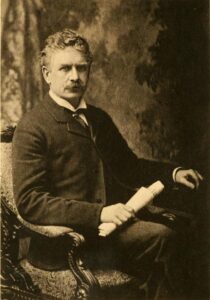Born: June 24, 1842
Died: 1914, Chihuahua, Mexico
Ohio connection: Birth
Horse Cave Creek, Meigs County
Ambrose Gwinett Bierce, known in his time as the “wickedest man in San Francisco” for his acid wit and punishing observations was born in a log cabin on Horse Cave Creek in Meigs County, Ohio, on June 24, 1842. The tenth of thirteen children born to poor farmer parents, the future satirist, newspaper columnist, and respected literary figure had no formal education until late adolescence. Due to his father’s great love of literature, however, the family did have a library to which Bierce once wrote that he owed “everything”. After working as a printer’s apprentice at age fifteen for an anti-slavery newspaper and enrolling in the Kentucky Military Institute, Bierce enlisted in the Union Army in 1861 to fight in the Civil War. Serving until 1865, he rose to the rank of lieutenant and fought in many well-known battles including Shiloh and Sherman’s March to the Sea. His Civil War experiences proved to be so influential throughout the rest of his life that biographer Richard O’Connor wrote, “War was the making of Bierce as a man and a writer.” In fact, Bierce’s war stories, which have been recognized as being among the best writings on war, can be found in the collections Tales of Soldiers and Civilians (1891) and Can Such Things Be? (1893). After the war, Bierce moved to San Francisco and began writing the opinions and social critiques for which he became famous and eventually known as “Bitter Bierce” and A.G.B.– “Almighty God Bierce.” His wit and black humor were also apparent in the macabre tales of death and horror he wrote, which were often compared to the writings of Edgar Allan Poe. These stories include “Chickamauga”; “An Occurrence at Owl Creek Bridge”; and “The Death of Halpin Frayser.” He is also well known for his fifty-three ghost stories. Bierce’s most acclaimed work, The Devil’s Dictionary (1906) was dedicated to “enlightened souls” who would appreciate his views on politics, religion, and society. His popularity as a writer was confirmed in modern popular culture with the movie From Dusk till Dawn 3: The Hangman’s Daughter, in which Bierce’s stagecoach is robbed in Mexico.
Tragically, Bierce’s ending was perhaps as terrifying as some of his stories. In 1914, he set out for Mexico to observe the Mexican Revolution by joining rebel Pancho Villa’s forces. He was never heard from again and is presumed to have died in the siege of Ojinega on January 11, 1914.
Books

Additional Resources
The Ambrose Bierce Project
Wikipedia: Ambrose Bierce
The Ambrose Bierce Letters Project


